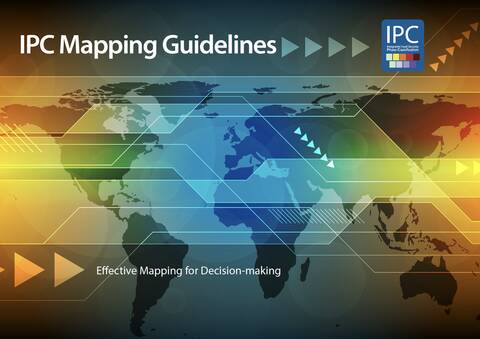IPC Mapping Guidelines

Type and Objective of Product
Communication Guidance Product
Maps play a pivotal role in IPC analyses, as they provide a visual and spatial understanding of food security and nutrition conditions across different administrative units. The IPC is designed to classify the severity and magnitude of food insecurity, helping stakeholders—including governments, humanitarian organisations, and international agencies—make informed decisions about interventions.
Maps help in several ways:
- Spatial Clarity: By visually representing data, maps allow analysts to see geographic patterns of food insecurity and malnutrition and quickly identify the areas most in need of assistance. This makes it easier to prioritise interventions and allocate resources more effectively.
- Complex Data Integration: Maps can combine various layers of information, such as population displacement and conflict zones, offering a multi-dimensional view of the factors influencing food security and nutrition.
- Timely Decision-Making: In crises where rapid responses are essential, maps help decision-makers quickly grasp the scope and severity of food insecurity, speeding up the process of mobilising affected regions.
Ownership
The IPC GSU is responsible for developing and managing the role out and dissemination and use of the IPC Mapping Guidelines.
Mandatory Content
IPC maps must include specific mandatory elements to communicate their intended information effectively while maintaining clarity, accuracy, and consistency. Here are the essential map elements:
- IPC Mapping Standards (IPC Manual 3.1): IPC mapping guidance follows standardised protocols for consistency, accuracy, and comparability across regions.
- OCHA COD Boundaries Standards: Administrative units, disputed areas, and cross-border food security concerns.
- Classification Colors for Every IPC Phase: Standard color guide for IPC Acute Food Insecurity and Malnutrition classifications.
- IPC Special Maps Symbology: Hatching/Patterns – Areas with limited data or multiple classifications.
- Disclaimers: Clarification on boundary disputes, scope, limitations, and intended use of IPC data.
Target Audience
The IPC Mapping Guidelines are designed to meet the needs of three key audiences, including:
- Mapping and Geographical Information Systems (GIS) experts.
- Communications Officers: Organizations responsible for communicating findings and raising public awareness through strategic communication efforts.
- Journalists: Media representatives writing about the crisis.
- Humanitarian Agencies: UN agencies, NGOs, and donors coordinating and executing humanitarian interventions.
Branding and Format
The IPC Mapping Guidelines follows standardised branding to ensure consistency and credibility:
- Size: Standard A5 book format for easy use.
- Fonts: The primary and secondary font is Myriad Pro, a sans-serif typeface with a classic and fresh appearance that aligns with the IPC brand.
Dissemination
IPC Mapping Guidelines are used and distributed through two channels to maximise reach and accessibility including:
- IPC Analysis workshops
- Media Engagement Forums: Training for journalists and media professionals through briefings and press kits.
- Communications Workshops and Webinars: Training sessions for stakeholders to understand and apply the guidelines.
- Printed Materials: Printing and distribution of booklets.
- Online Platforms and E-learning Modules: Host guidelines on IPC websites and learning platforms.
- Email: Regularly update stakeholders with IPC communication best practices and case studies.